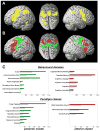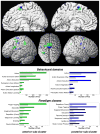Co-activation patterns distinguish cortical modules, their connectivity and functional differentiation
- PMID: 21609770
- PMCID: PMC3129435
- DOI: 10.1016/j.neuroimage.2011.05.021
Co-activation patterns distinguish cortical modules, their connectivity and functional differentiation
Abstract
The organization of the cerebral cortex into distinct modules may be described along several dimensions, most importantly, structure, connectivity and function. Identification of cortical modules by differences in whole-brain connectivity profiles derived from diffusion tensor imaging or resting state correlations has already been shown. These approaches, however, carry no task-related information. Hence, inference on the functional relevance of the ensuing parcellation remains tentative. Here, we demonstrate, that Meta-Analytic Connectivity Modeling (MACM) allows the delineation of cortical modules based on their whole-brain co-activation pattern across databased neuroimaging results. Using a model free approach, two regions of the medial pre-motor cortex, SMA and pre-SMA were differentiated solely based on their functional connectivity. Assessing the behavioral domain and paradigm class meta-data of the experiments associated with the clusters derived from the co-activation based parcellation moreover allows the identification of their functional characteristics. The ensuing hypotheses about functional differentiation and distinct functional connectivity between pre-SMA and SMA were then explicitly tested and confirmed in independent datasets using functional and resting state fMRI. Co-activation based parcellation thus provides a new perspective for identifying modules of functional connectivity and linking them to functional properties, hereby generating new and subsequently testable hypotheses about the organization of cortical modules.
Copyright © 2011 Elsevier Inc. All rights reserved.
Figures





References
-
- Amunts K, Schleicher A, Zilles K. Cytoarchitecture of the cerebral cortex--more than localization. Neuroimage. 2007;37:1061–1065. - PubMed
-
- Anwander A, Tittgemeyer M, von Cramon DY, Friederici AD, Knosche TR. Connectivity-Based Parcellation of Broca’s Area. Cerebral Cortex. 2007;17:816–825. - PubMed
-
- Behrens TE, Woolrich MW, Jenkinson M, Johansen-Berg H, Nunes RG, Clare S, Matthews PM, Brady JM, Smith SM. Characterization and propagation of uncertainty in diffusion-weighted MR imaging. Magn Reson Med. 2003;50:1077–1088. - PubMed
-
- Biswal B, Yetkin FZ, Haughton VM, Hyde JS. Functional connectivity in the motor cortex of resting human brain using echo-planar MRI. Magn Reson Med. 1995;34:537–541. - PubMed
-
- Bremmer F, Schlack A, Shah NJ, Zafiris O, Kubischik M, Hoffmann K, Zilles K, Fink GR. Polymodal motion processing in posterior parietal and premotor cortex: a human fMRI study strongly implies equivalencies between humans and monkeys. Neuron. 2001;29:287–296. - PubMed
Publication types
MeSH terms
Grants and funding
LinkOut - more resources
Full Text Sources

